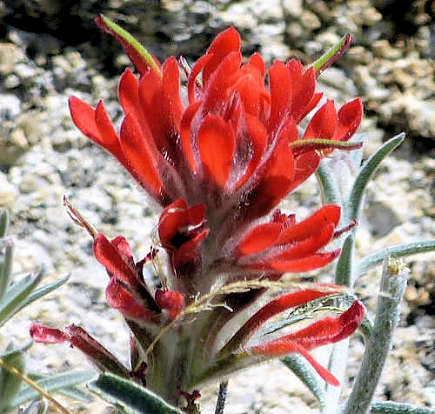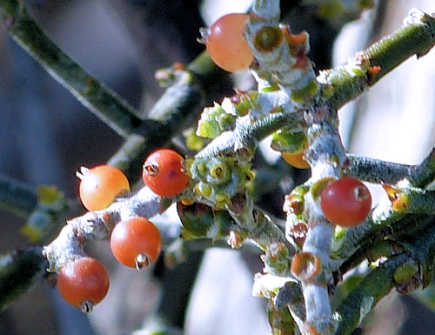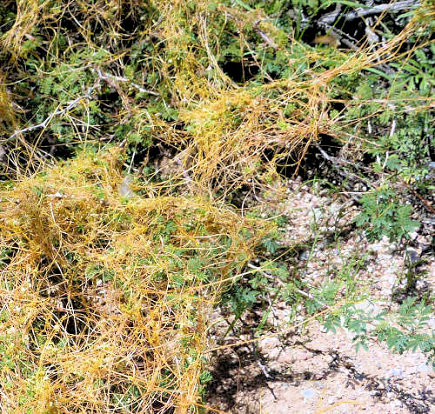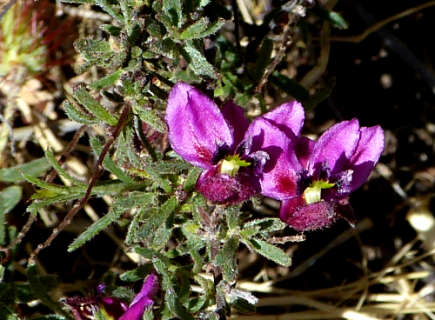Parasitic Plants
FOOD PLANTS
Culinary Herbs
Fruit, Berries, Nuts
Peppers, Chilies
Strawberries
Tomatoes
Vegetable Calendar Zone 9
ORNAMENTALS
Grasses
Ground Cover
Perennials
Shrubs
Succulents
Trees and Palms
Vines
SPECIALTY GARDENS
Butterfly Garden
Erosion Control
Fragrance Garden
Hedges, Barriers, Screens
Hummingbird Garden
Long Blooming
Winter-Blooming
GARDENING TIPS
Dealing with Critters
Digging Holes for Plants
Fruit: Selection, Cultivation
Garden Bed: Sterilizing
Landscaping
Microclimates
Parasitic Plants
Plant Placement
Selecting Plants
Soil Prep for Vegetables
USDA Hardiness Zones
Planting, Watering, Shrubs, Trees
NURSERIES / SUPPLIES
Online
Phoenix
Tucson
MEETINGS
Phoenix Meetings
Tucson Meetings

Castilleja: Indian Paintbrush
comprises 109 species across North America. The noticeable "flower" consists of bracts,
usually bright red or orange, which hide small flowers. These flowers are narrow tubes formed
by petals, often yellow or green. Paintbrush blooms late winter, spring or summer. A
semi-parasite, Paintbrush is always found next to a companion plant, very often grass, which
it invades through its roots. Transplanting one from the wild usually kills the plant. Most
are short-lived perennials.
To grow this plant from seed, first sow seeds of a companion plant in a seed-starting medium indoors. As those seeds begin to sprout, sow the Paintbrush seeds next to them. When the seedlings are large enough to survive outside, place them in an outside area with part shade for the first five days.


Phoradendron californicum: Desert Mistletoe
is a perennial parasite occurring on trees such as Acacia, Mesquite, Ironwood, and Palo
Verde.
Velvet Mesquite and Catclaw Acacia are especially susceptible.
A partial parasite, Desert Mistletoe is capable of photosynthesizing, but its roots invade
the bark of the host plant and take in water and some nutrients.
Desert Mistletoe has narrow scale-like leaves resembling a clump of grass that can be green, yellow-brown or brown. Its flowers are tiny and yellowish-green.
The fruit are pinkish-orange, non-sticky berries that ripen in winter. Birds feed on the berries, which turn sticky in their digestive tracts. They then disperse the seeds to the bark of trees.
If many clumps of mistletoe form on a tree, the tree will appear malformed and lifeless, having few leaves and only mistletoe clumps. One course of action is to cut off the branch of the tree 1-3' (30-90cm) below the attachment point of the Mistletoe when the parasite is first noticed. However, the Mistletoe can reappear. Once it is as large as that shown in the photo, the best option may be to cut the host tree to the ground. Both Acacia and Mesquite trees will re-sprout from stumps. There are no chemical treatments.
There are 24 species of Phoradendron in North America.

Cuscuta: Dodder
is a parasite that looks like yellow string entwining a green plant.
Its roots infiltrate the stems of a host to derive nourishment.
It will attach to almost any plant species and some vegetable crops can be
devastated. Dodder may ensnare several adjoining plants and has been shown to
transmit viral diseases.
Its stems may be yellow, orange or white in color. It produces small white spherical flowers, appearing mainly July through September. Seeds are distributed by wind or by the manure of animals. Seeds can remain in the ground for up to five years before germinating. When it sprouts, the Dodder vine will find the stem of a nearby green plant, attach itself, and detach from its own seedling roots.
Eradication is achieved only by cutting the host (green) plant to the ground. Native plants will grow back. Dodder grows quickly and early eradication is best. Constant vigilance is required once a single infestation is found.
The Cuscuta genus contains 127 species of Dodder.


Krameria erecta: Littleleaf Ratany
is a sprawling, tangled, perennial shrub that grows low to the ground. While deceptively
appearing to be independent, it is semi-parasitic, getting water and nutrients from the roots
of nearby plants, apparently without harming them. Its hairy, linear leaves perform
photosynthesis.
It has odd-shaped, magenta flowers that bloom in clusters, once or twice, spring to end of summer. The flowers contain oil glands rather than nectar. Female bees of the genus Centris use the oil mixed with pollen to feed their larvae. The fruit are covered with reddish spines and contain one brown, nut-like seed, heart-shaped, with a ridge in the middle. The plant reproduces by seed.
Four species of Krameria exist in the desert southwest, all somewhat variable in appearance.
Do you have additional information or a different experience for these plants that you would like to share?Email info@GardenOracle.com. All contributions are welcome and appreciated.
Latest update: September, 2024
© 2008-2025 by GardenOracle.com

